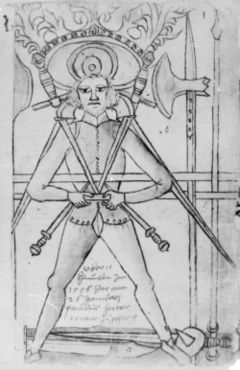- Codex Wallerstein
-
The Codex Wallerstein (Augsburg University library I.6.4.2) is a 16th century fechtbuch. The title Vom Baumans Fechtbuch appears on the first page, together with the date 1549. The Codex came in the possession of Paulus Hector Mair in 1556. It consists of 221 pages, illustrating techniques of fighting with the longsword, messer, and dagger, armored and unarmored, stechschild, as well a system of grappling.
The manuscript is a convolution of three parts, clearly separable by three different styles of illustration. The part A treats longsword, dagger and messer. The part B is inserted in two parts, interrupting the first part, treating grappling. The part C treats longsword, armoured combat, stechschild and grappling.
The swords depicted are of a tapering longsword style. The fighting style is predominantly in Liechtenauer's tradition, but includes several close-quarter techniques from Fiore dei Liberi's tradition as well.
Part A is considered a source for the fechtbuch of Albrecht Dürer of 1512. A note on fol. 56v indicates that part B post-dates part A. Part C is probably the oldest, dating to the mid-15th century, the illustrations possibly by a professional draftsman of playing-cards, while parts A and B may date to the 1470s, possibly by one Michael Baumann, listed as a mercenary by profession in the tax registers of Augsburg between 1471 and 1495. The present confused sequence of the pages is the result of a binding in the 16th century.
Contents
Contents
- 1r drawing of a fencer with various arms
- 1v-2r drawing of a fighting arena with spectators
- Part A
- 3r-14v, 21r, 21v longsword techniques
- 22r-28v dagger
- 29r-32v messer
- Part B
- 15r-20v, 33r-74r grappling
- 74v drawing of an armed robbery (with instructions for the robber to draw blood from the victim's neck for intimidation)
- Part C
- 76r-80v, 101r-102v longsword
- 81r-95v, 103r-107r armoured combat
- 96r-96v, 98v judicial combat, Swabian law
- 97r-98r judicial combat, Franconian law
- 98v-100v grappling
- 108v four figures dressed in the style of the 13th century
- 109r register, in the hand of Paulus Hector Mair
See also
- Fechtbuch
- Historical European martial arts
- Wallerstein, a town, castle and noble family in Germany Fürst Wallerstein - Unternehmen
Literature
- G. Zabinski, with B. Walczak, Codex Wallerstein, A Medieval Fighting Book from the Fifteenth Century on the Longsword, Falchion, Dagger, and Wrestling, Paladin Press, (2002), ISBN 1-58160-339-8. [1]
External links
- Codex Wallerstein transcription
- http://www.thearma.org/Manuals/CodexW.htm
- Book Review by David M. Cvet on "Codex Wallerstein: A Medieval Fighting Book from the Fifteenth Century on the Longsword, Falchion, Dagger, and Wrestling"
- http://ejmas.com/jwma/articles/2001/jwmaart_zabinski_0401.html
- http://www.guerriers-avalon.org/messer/wallerstein_messer.html
Categories:- 15th-century books
- Combat treatises
- Illustrated manuscripts
Wikimedia Foundation. 2010.


